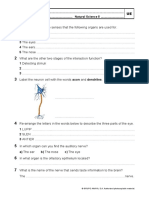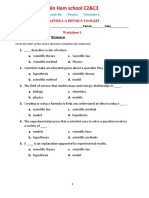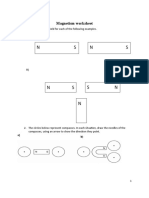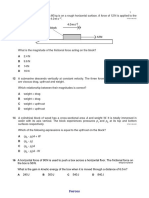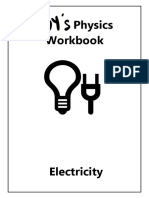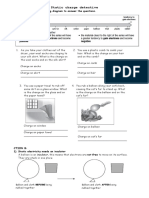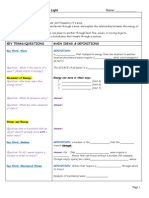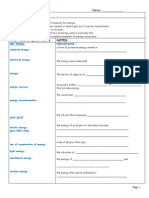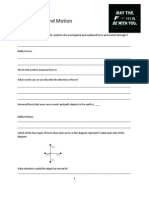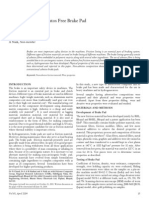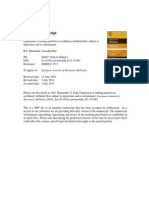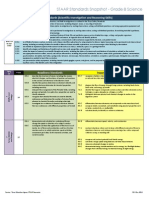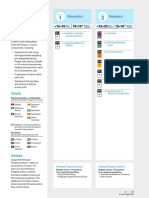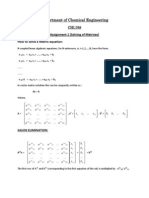Guided Notes for Unit 8: Electricity and Magnetism
Lesson 1: Electric Charge
Objectives
Describe how charged objects experience forces of attraction or repulsion. Explain that objects become electrically charged when they gain or lose electrons. Describe the area where one or more charged particles exert a force on another charge as an electric field. MAIN IDEAS & DEFINITIONS
Answer:
Electric charges come from specific parts of an _______. Every atom has a ___________ It contains ________________ charged protons The __________ is surrounded by ______________ charged electrons
KEY TERMS/QUESTIONS
How Do Electric Charges Interact?
Question: Where do electric charges come from?
Question: What happens when charges meet?
Answer:
Opposite charges _______________ each other o This force of attraction is the same one that keeps negatively charged ________________ attracted to, and orbiting the _______________ nucleus of an atom. Like charges _____________ each other. consist of CHARGED particles Each electron has a charge of:_____ Each proton has a charge of: _____ You can ADD these together (or subtract if need be) Atoms are NEUTRAL (no charge) when __________ equal ____________ Atoms with unequal numbers of charged particles are called ______ o o Ions are positive when there are more _________ than electrons Ions are negative when there are more _________ than protons
Atomic Particles Have Electric Charges Atoms
Question: a) How many protons are in this Chorine atom? b) How many electrons? c) Is it an ion or a neutral atom? d) What is the atoms total charge?
Answer:
a) b) c) d)
Page 1
�Guided Notes for Unit 8: Electricity and Magnetism
Large Objects Have Electric Charges
Question: Can objects besides atoms have electric charges? Question: Provide an example
Answer:
Yes. Everyday objects can also have electric charges. This occurs when the atoms of the object ________ or _______ electrons. Example: Balloon rubbed with wool. _________ move from atoms in the ________ to atoms in the _________ The balloon takes on a _____________ charge. Close to the wall, the electrons in the balloon ___________ the electrons in the wall, leaving the __________ on the walls surface. The wall surface is now _______________ charged. Because they are oppositely charged, the balloon is _____________ ____ to the wall.
Question: Is the force of electric charge greater than gravity? Explain.
Answer:
Question: If you rubbed two balloons with wool cloth and held them close together, what would happen?
Electric Fields Key Word: Electric Field
Answer:
DEFINITION: the _________ throughout a _________due to one or
more ________________ __________ particles or surfaces
The __________ of a particles electric __________ on other objects depends on the objects ______________ from the charge. The field is ___________ at a point ____________ to the charge than it is at a point _______ away.
So, the effect of two charges on one another _______________ as the charges move ____________ apart.
Electric Force
Question: How can you change the electric force between two charged objects? Question: a) What happens when the charge increases? b) What happens when the distance increases?
Answer: The electric force between two charges (or charged objects) depends on two things: 1. Amount of ________________ on each object and 2. The ____________________ between the objects/charges Answer: a) As charge increases, electric force ____________ b) As distance increases, electric force ______________
Page 2
�Guided Notes for Unit 8: Electricity and Magnetism
Question: Why do two balloons similarly charged need to be close together to repeal each other? Answer:
Where Do the Electrons Go?
Electrons are free to move. Some objects take on electrons easily Some give up electrons easily Answer:
Question: When you comb your hair on a dry day, why do some of your hair strands appear to float apart? Question: Why do clothes stick together in the dryer?
Answer:
Electroscope Key Word: Electroscope
DEFINITION: an instrument for detecting _________ electricity
Question: How can you tell if an object is electrically charged?
Answer:
When you touch a charged object to the electroscope, the ____________ will move into (or out of) the scope and give the leaves of the electroscope the same charge. Since the leaves have like charges, they will _________ ____________
What Happens to Electric Charges?
Electric charges can either _______ ___ on the surface of an object, or they can ________ When charges build up, we call this ____________ electricity When charges move, we call this _____________ ________ Example(s):
Key Word: Electric Current
DEFINITION: the ___________ of electrons through a wire (or other
material)
REMINDER:
Please complete the lesson review for lesson 1 in your student pages.
Page 3
�Guided Notes for Unit 8: Electricity and Magnetism
Lesson 2: Electric Currents
Objectives
Define electric current and electricity as a flow of charged particles (such as the flow of electrons in a wire). Explain how electric resistance affects current. Identify materials as conductors or insulators of the flow of electricity. MAIN IDEAS & DEFINITIONS
DEFINITION: Any material through which electricity _____ ______.
Example(s):
KEY TERMS/QUESTIONS
Conductors Carry Currents Key Word: Conductor
Question: Why do metals make good conductors?
Insulators Stop Currents Key Word: Insulator
Answer:
DEFINITION: A substance that ________ conduct electricity very well.
Example(s):
Question: How is an insulator like a dam? Question: Are all non-metals good insulators?
Resistance and Electrical Currents
Answer:
Answer:
Question: Is there such a thing as a perfect insulator something that can stop ANY current, no matter how large?
Answer: Yes/No (Circle One) Explain:
Even excellent conductors will _______ ________ electric current Even excellent insulators will allow __________ to flow if they become overwhelmed
Key Word: Resistance
DEFINITION: the quality of a substance that __________ the flow of
electrons through it ALL materials ___________the flow of electrons to some degree (conductors less than insulators) As electrons encounter resistance, they ________ _______
Question: When electrons encounter resistance and slow down, WHERE does their energy go? Question: Can resistance be dangerous?
Answer: The energy is converted to ____________
Examples of household devices that use resistance:
Answer: Yes/No (Circle One)
Explain:
Page 4
�Guided Notes for Unit 8: Electricity and Magnetism
What Makes Electricity Flow? Because electrons repel one another and are attracted to objects with a positive charge, they will flow from negative to _________ So, in order to create current, you must first find a way to create this DIFFERENCE in ___________ This is called an electrical potential (which we also known as voltage)
Question: What are some ways we can make electricity flow by creating this electrical potential?
Answer/Examples:
Can Electrons Be Used Up?
Answer: Yes/No
Explain: Electrons never disappear, but they can reach a _______ ____ and stop ___________ (we say they are no longer free to move) Keeping Electrons on Track As you now know, electricity flows in a _________ and can be used to do ________, such as lighting a light bulb. Take a look around you. Name at least 5 things around you that are powered by electric currents:
1. 2. 3. 4. 5.
REMINDER:
Please complete the lesson review for lesson 2 in your student pages.
Page 5
�Guided Notes for Unit 8: Electricity and Magnetism
Lesson 3: Electric Circuits
Objectives
Interpret and compare diagrams of open and closed electric circuits, including series and parallel circuits. Analyze and label the parts of an electric circuit. Explain how electric current flows in series and parallel circuits and describe the advantages and disadvantages of each type of circuit. Describe an electric circuit as a complete closed path for an electric current. Explain how electric resistance affects current. MAIN IDEAS & DEFINITIONS
KEY TERMS/QUESTIONS
Circuits: Keeping the Flow
Question: How are electrons flowing in a current like the chimpanzees in a line?
Answer:
CIRCUITS: An electrical current can only exist if electrons are ________. The current needs a medium, or _____________, through which to flow. Because the conductor always has some ________________ electrons continue to flow only if a constant ___________ is pushing on them. If the conductor ends at the same place it begins, the force of ___________________ will continue to keep the electrons moving.
Key Word: Electric Circuit
DEFINITION: a continuous, looped ___________ ____________
around which electricity flows
Circuits: Not Just a Bunch of Wires
Question: How do you get electrons to begin flowing in the first place?
Answer: you need a source of ___________ that will _______ into the
loop and cause the current to flow. A common source of electrons is a _____________ Batteries store two different chemicals: One tends to ________ electrons The other tends to ________ them This creates an ____________ field, with one pole being more ______________ and the other being more _____________ When a conductor (like a wire is connected to the two poles), the electrons naturally begin to flow
Question: Which way do the electrons flow?
Answer: Electrons ALWAYS flow from ___________ to __________
Page 6
�Guided Notes for Unit 8: Electricity and Magnetism
Resistors: Resisting The Flow
Question: When resistance increases, what happens to current flow?
Answer: Just like a clogged pipe that wont let much water through, a
material with high resistance wont let much _________ flow either. As resistance increases, current flow __________ As resistance decreases, current flow __________
Question: How can you tell if youve successfully created a simple circuit (is current flowing)?
Answer:
An easy way to test your work is to include a __________ of the right kind in the circuit. You will know electricity is flowing because the resistance in the circuit will cause energy to be converted into _______ or _______ Example: An electric charge needs a _________ circuit to flow. Switches can be used to control the flow of electrons by _________ and __________ the circuit When a circuit is open, electrons ___________ flow.
Switches Stop The Flow
Series vs. Parallel Circuits
Question: 1. When might you want to use a parallel circuit, rather than a series circuit? 2. When might a series circuit be better than a parallel circuit?
Answer:
1.
Series Circuit vs. Parallel Circuit:
SERIES: o Uses _______ continuous wire from the battery through the light bulbs. o GOOD: All current flows through EVERY device full power is delivered o BAD: If any ONE bulb burns out, however, then the circuit is _________ and ALL bulbs/devices will go out.
2. PARALLEL: o Has _______ sets of wires, creating multiple paths through which current can flow. o GOOD: If one bulb burns out, will the circuit be broken? Yes/No (Circle one) o BAD: The current DIVIDES (like water flowing past islands), so each device has less overall power.
REMINDER
Please complete the lesson review for lesson 6 in your student pages.
Page 7
�Guided Notes for Unit 8: Electricity and Magnetism Lesson 4: Your Choice (Just mark this complete in the OLS)
Lesson 5: LAB: Series and Parallel Circuits (Student Pages 361-364)
Objectives
Explain how electric current flows in series and parallel circuits and describe the advantages and disadvantages of each type of circuit. Create parallel and series electric circuits. Interpret and compare diagrams of open and closed electric circuits, including series and parallel circuits. Analyze and label the parts of an electric circuit.
Lesson 6: Magnetism
Objectives
Identify materials that are magnetic. Explain a diagram that shows the lines of force in a magnetic field. Compare a magnetic field with an electrical field MAIN IDEAS & DEFINITIONS
Magnets exert a force of _______________________, which means they push other magnets away. Magnets also exert a force of ________________, which means they attract other magnets and certain types of metals.
KEY TERMS/QUESTIONS
Fill in the blanks: Magnetic fields
Key Word: magnetic poles
DEFINITION:
The two ends of a magnet, where the _________________ ________________ is especially strong. Bar magnets have _______ magnetic poles.
Question: What happens to the poles when you cut a magnet in half?
Key Word: dipolar
Answer: DEFINITION:
an object with two sides that have ___________________________ characteristics Notes: Unlike poles _____________________________one another, and like poles _______________________ one another.
Fill in the blanks: Magnetic poles
Page 8
�Guided Notes for Unit 8: Electricity and Magnetism
Key Word: domains
DEFINITION:
a small region in which _______________________________ atoms that have magnetic fields _______________________________ with their magnetic fields oriented in the ____________________________ direction
Key Word: Permanent magnets
DEFINITION: Permanent magnets are made in a
_________________________ with all their ____________________ material _____________________________ more in one direction than others. Their overall magnetic force is strong and they are unlikely to go back non-magnets.
Key Word: Temporary magnets
DEFINITION:
They behave like magnets only when in the presence of _______________. These items alone do not exert a discernible _________________ ____________________.
Examples are:
Question: How do you make a nail magnetic?
Answer:
Key Word: magnetic field
DEFINITION:
The ____________________ around every magnet where the magnetic ___________________ can be felt. Magnets ______ ______ have
to touch an object to exert a force on it. The force is ________________ near the poles and becomes ______________________ further away from the poles.
Question: How does a compass work? Reminder:
Answer: Please complete the lesson review for lesson 6 in your student pages.
Page 9
�Guided Notes for Unit 8: Electricity and Magnetism
Lesson 7: Electricity and Magnetism
Objectives
Explain how a magnetic field can be created by an electric current flowing in a wire. Describe how different variables influence the strength of an electromagnet. KEY TERMS/QUESTIONS MAIN IDEAS & DEFINITIONS
Remember: Permanent magnets are
usually made in a factory with all their domains aligned. Temporary magnets behave like magnets only when they are near permanent magnets. Key Word: electromagnetic List: Permanent magnet: Temporary magnet:
DEFINITION:
A ____________________________ magnet made using _______________________ ___________________, usually running around a _____________________core. As long as electric charges are
flowing through the wires, the electromagnet holds the metal tightly. The electric current stops flowing through the wire, and the magnetic field disappears. Question: Why wouldnt a permanent magnet work in a salvage yard where they need to pick up and release metal? Question: How can you make an electromagnet? Answer:
Answer:
Notes: A simple electromagnet like the one shown, typically consists of 3 main parts:---------------------
1.
____________________ ___________________: such as a battery 2. ____________________ ___________________: such as an iron nail or screw 3. ____________________: coiled around the metal core, and connected to the battery to carry the electric current
Page 10
�Guided Notes for Unit 8: Electricity and Magnetism
Notes: The strength of an electromagnet depends on two factors. List them to the right and give details about how to create those factors.
Notes:
1.
2.
Key Word: galvanometer
DEFINITION: an instrument that uses a movable ________________
_________________ to detect the _______________________ magnetic field around an ________________________ current.
Question: How can you make one?
Answer:
Reminder:
Please complete the lesson review for lesson 7 in your student pages. Please also do the investigation about creating an electromagnet.
Lesson 8: LAB: Motoring On (Student Pages 381-386)
Objectives
Create an electric motor Page 11
�Guided Notes for Unit 8: Electricity and Magnetism
Lesson 9: Motors and Generators
Objectives
Describe how an electric current is created when a circuit is exposed to a changing magnetic field. Explain how generators convert mechanical energy into electrical energy. KEY TERMS/QUESTIONS MAIN IDEAS & DEFINITIONS
Key Word: motor
DEFINITION:
a machine that converts ______________________ energy into ______________________ energy
Notes: How a motor works
Notes: The electric current _________________________the coil, which then turns as the coils magnetic field is _______________________ a nd ______________________________to the stationary magnets.
Key Word: generator
DEFINITION: Electric generators ______________________mechanical
energy into _______________________________energy. By applying a mechanical force to turn the rod, the coil becomes _____________________________ and generates an _________________________ current.
Questions: To generate large amounts of electricity, generators rely on powerful sources of mechanical energy. What are examples of some of these sources?
Answer/Examples:
Reminder:
Please complete the lesson review for lesson 9 in your student pages. Please also do the investigation about generators in history.
Lesson 10-12: Unit 8 Model Problems, Review and OLS Assessment
Page 12





